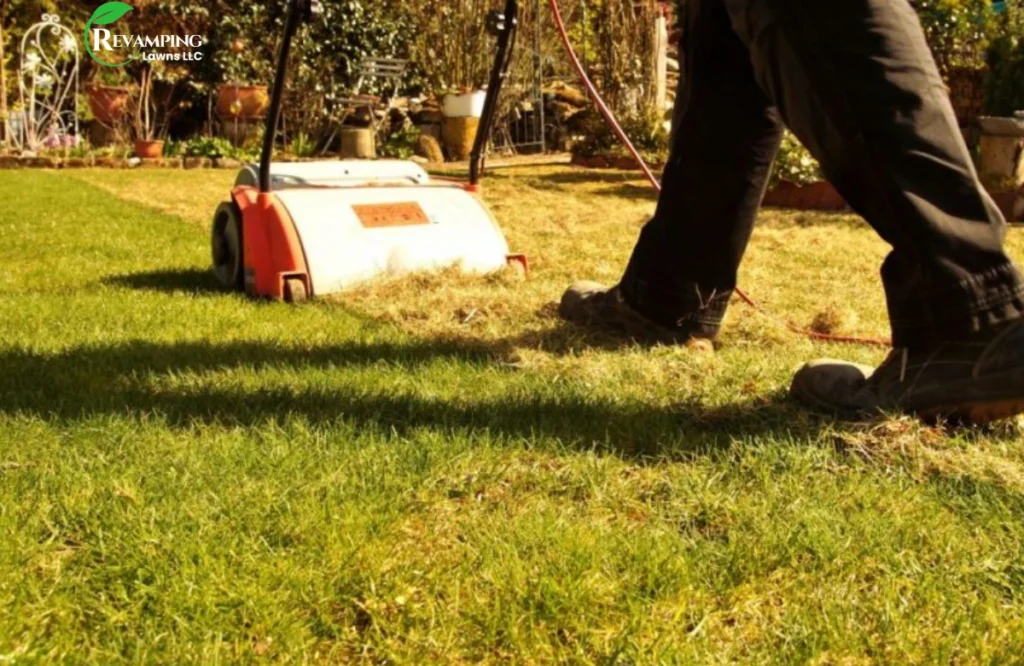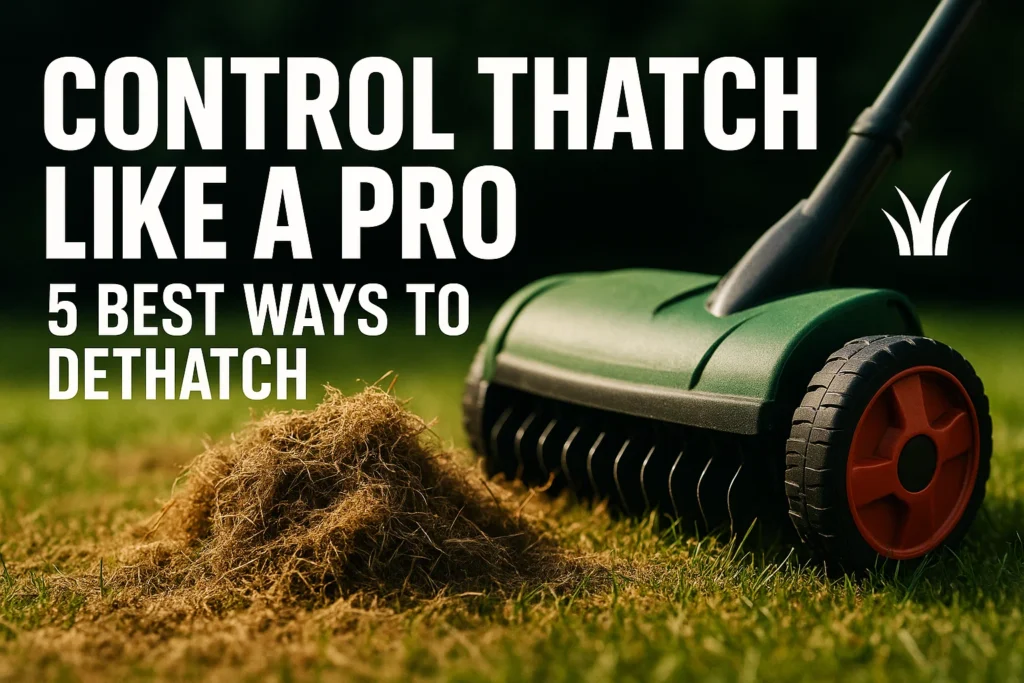Thatching is one of the problems of lawn care that most homeowners experience. It is a layer of living and dead grass stems, roots, and other organic material, accumulated between the soil surface and the green grass stems. Although a little thatch may be beneficial in keeping the lawn healthy and strong, too much thatch may suffocate the grass roots, prevent the passage of water and food, and provide a good habitat for pests and diseases. This guide will discuss the reasons and the consequences of lawn thatch, the most proven ways to eliminate thatching, and some practical advice to have a healthy and green lawn throughout the year.
What is Thatching in Lawns?
Thatch is a thick mat of dead and living plant matter- stems, roots, and leaves- that builds up over the soil and under the canopy of grass. This organic layer usually breaks down by natural soil microbial activity. However, when the rate of organic matter production exceeds the rate of decomposition, then thatch starts to accumulate too much.
Causes of Thatch Buildup
- Over-fertilization and watering, which encourage the quick growth of grass.
- Poor or unmowing resulting in long grass clippings.
- Compaction of soil and inadequate aeration that lower microbial activity.
- Unfavorable soil conditions to decomposing organisms, e.g., high PH or excessive use of pesticides.
- Some grasses such as Kentucky bluegrass, bermudagrass, and zoysia that naturally form more thatch.
Best Ways to Remove Thatch in Your Lawn
1. Mechanical Dethatching
Mechanical dethatching is the manual removal of the thatch layer with dethatching rakes or powered lawn dethatchers with blades or tines attached. This procedure slices the thatch and draws it up, to enable the grass underneath to breathe and absorb nutrients more effectively.
- Ideal on lawns with a thatch more than 0.5 inches.
- Must be performed in active growing seasons (spring or early fall) to recover quickly.
- Fertilizing and overseeding to repair the health of the lawn is often followed.
2. Core Aeration
Core aeration extracts small soil and thatch plugs out of the lawn to lessen compaction and enhance air, water, and nutrient uptake. Aeration enhances the microbial activity in the soil, which breaks down thatch in the long run.
- Assists with medium to heavy compaction of lawns.
- Recommended 1-2 times a year.
- Works well together with topdressing to fill aeration holes and enhance soil quality.
3. Topdressing with Compost
Applying a thin layer of organic compost on the lawn is beneficial in nourishing good microorganisms and also hastens the process of thatch decomposition. Compost also enhances the general soil structure and fertility.
- Its use is best as a maintenance technique with aeration.
- Use 1/4 inch good compost in spring or fall.
- Supports slow elimination of thatch and encourages deep rooted lawn.

4. Proper Lawn Maintenance
The following practices can prevent excessive thatch accumulation or lessen thatch: regular lawn care practices:
- Mow often at the suggested grass type height to prevent long clippings.
- Do not overwater and over-fertilize this may encourage rapid growth.
- Mulch with the help of mulching mowers that cut the clippings into small pieces so that they can decay fast.
- Keep the soil healthy by testing the pH and making corrections.
5. Biological Thatch Control
Some microbial products and enzymes may be used to promote the natural thatch breakdown. These biological treatments improve life in the soil that digests the organic material in thatch.
- Applicable best along with mechanical methods.
- Needs to be used regularly over a number of seasons.
- The effectiveness will be different based on soil and lawn conditions.
Thatching vs. Dethatching: What’s the Difference?
| Aspect | Thatching | Dethatching |
| Definition | Accumulation of dead and living organic matter (grass stems, roots) between soil and grass blades | The process of removing excess thatch from the lawn surface |
| Purpose/Effect | Thatch provides some insulation but excess blocks air, water, and nutrients | Dethatching restores lawn health by removing harmful thick thatch |
| Causes | Natural grass growth, slow decomposition, and over-fertilization | Manual or mechanical removal of thatch |
| Impact on Lawn | Excessive thatch causes disease, pest habitat, and root suffocation | Improves water, air, and sunlight penetration; promotes root growth |
| Method | Passive buildup over time | Active removal using rakes, dethatchers, or power equipment |
| When to Address | Monitor when thatch exceeds 0.5 inches | Dethatch when thatch is thick and the lawn suffers |
| Tools/Techniques | None (natural process) | Manual rakes, power dethatchers, vertical mowers |
The Pros and Cons of Lawn Thatch
Lawn thatch is a naturally formed layer of dead and live grass stems, roots and organic debris that forms between the soil surface and the green grass blades. Although it is usually regarded as a problem when it is too thick, thatch has positive and possibly negative effects on the health of the lawn.
Pros of Lawn Thatch
- Insulate soil and stabilize temperature changes.
- Helps retain soil moisture.
- Protects soil from erosion.
- Supports positive soil microbes and earthworms.
- Acts as natural mulch, suppressing weeds and softening foot traffic.
Cons of Lawn Thatch
- Blocks air, water and nutrients when excessive.
- Harbors pests and lawn diseases.
- Causes shallow root growth, decreasing drought resistance.
- Makes a spongy lawn surface.
- Makes water penetration hard, causes pooling or run-off.
Conclusion
Thatch is a natural component of the lawn that grows, but when it accumulates, it may negatively affect the health and appearance of the grass. The initial step of knowing the reasons and the consequences of thatching is the starting point to successful lawn care. Mechanical dethatching, using core aeration and topdressing with compost are the most proven and effective means of eliminating thatch. Through effective maintenance of the lawns and use of biological controls, these methods enable one to maintain a healthy balance of organic matter in the earth and enable a lush and strong lawn.
FAQs
Dig out a small core of turf. When the thatch layer is greater than 0.5 inches thick, then it must probably be removed.
No, the rightly mulched grass clippings break down fast and do not add to the thatch accumulation.
The most favorable hours are the growing seasons, which are typically spring or early fall, thus the lawn heals fast.
1-2 times a year can be used, depending on the soil compaction, particularly before topdressing.
When properly and at the appropriate time, dethatching enhances the health of the lawn. It should not be done too many times or when the grass is dormant because this will stress the lawn.



